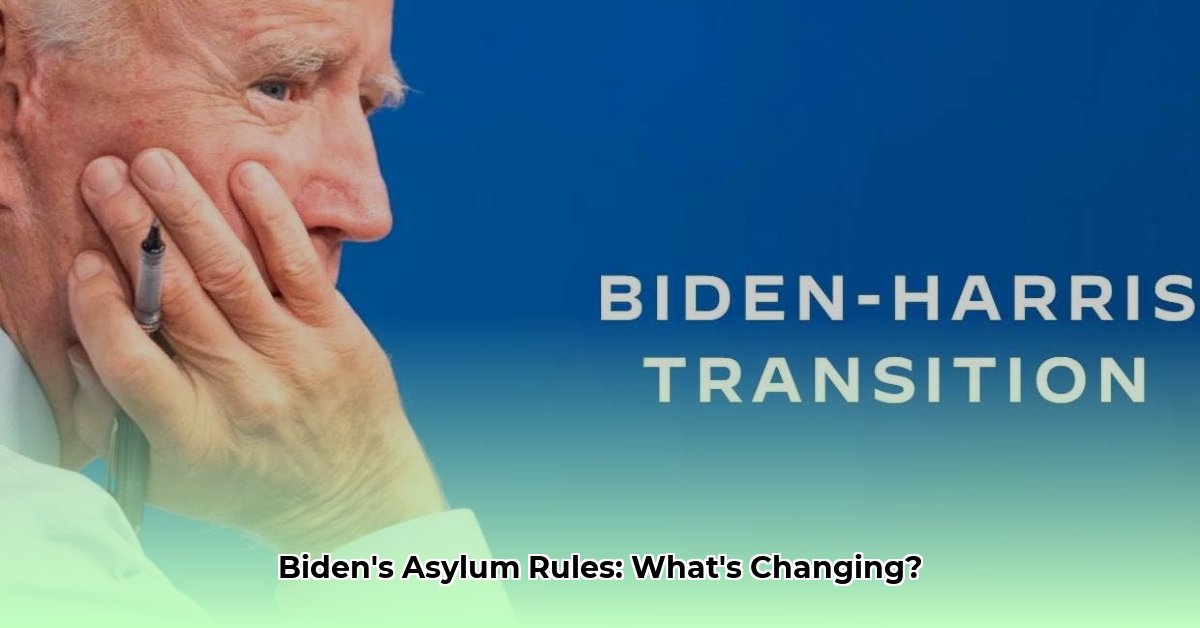Reshaping Asylum: Examining the Biden Administration’s Approach
The transition from the Trump to the Biden administration marked a significant shift in U.S. asylum policy. While President Biden campaigned on a more humane approach, the implementation of his policies has been complex and fraught with challenges, sparking controversy and raising questions about the future of asylum in the United States. This article analyzes the key policy changes, their potential impacts, and the surrounding political context.
From Trump to Biden: A Change in Course?
The Trump administration’s hardline stance on immigration, prioritizing border security above all else, resulted in significant obstacles for asylum seekers. Policies like the “Remain in Mexico” program (officially the Migrant Protection Protocols or MPP) forced asylum seekers to wait in often dangerous conditions in Mexico while their cases were processed. Biden, promising to restore the asylum system and uphold humanitarian principles, pledged a more welcoming approach emphasizing due process and access to legal counsel. However, dismantling existing policies and establishing a new framework proved more difficult than anticipated, given the strained system, a substantial backlog of cases, and limited resources.
Policy Shifts and Their Implications
The Biden administration took several key actions, including attempting to terminate the MPP. Legal challenges and court injunctions, however, hampered these efforts. Simultaneously, the administration sought to increase refugee admissions, signaling a move towards a more humanitarian approach. This increase, though, faced criticism for being too slow and insufficient to address the global refugee crisis, compounded by resettlement agencies struggling to rebuild capacity and pandemic-related complications.
One of the most controversial moves was the expansion of Title 8 expedited removals, streamlining deportations for those deemed inadmissible. Coupled with a revised “transit ban,” which restricts asylum for those who traveled through another country first, these policies sparked concern among human rights advocates who argued they could unfairly penalize vulnerable individuals.
The introduction of the CBP One app, a mandatory tool for asylum seekers to schedule appointments, aimed to streamline the process. However, concerns arose regarding accessibility for those with limited technology access or language barriers. The debate continues regarding its effectiveness and potential to exclude vulnerable populations. Increased border enforcement, including more personnel and technology, also raised questions about whether it truly deters illegal crossings or merely forces asylum seekers to more dangerous routes.
Balancing Act: Security vs. Humanitarianism
The Biden administration’s approach has been a balancing act, attempting to address both border security and humanitarian concerns. This has led to a mixed reception. Human rights advocates argue the administration hasn’t gone far enough in reversing restrictive policies, citing high deportation rates and difficulties asylum seekers face in accessing legal representation. Conversely, critics express concern that the new policies contribute to operational challenges at the border and insufficiently address security. This tension underscores the ongoing challenge of finding a sustainable balance between these competing priorities.
Unintended Consequences and Uncertainties
The long-term effects of these policies remain uncertain. There are concerns about their impact on the U.S. immigration system, international relations, and the lives of asylum seekers. Will the changes deter irregular migration or simply push people to more perilous journeys? Will they streamline the asylum process or create new barriers? Ongoing research and analysis are crucial for understanding the true impact and potential unintended consequences, such as an increase in human smuggling.
Controversy and Public Reaction
The shift in asylum policy sparked intense debate. Trump administration officials criticized Biden’s approach, arguing it encouraged illegal border crossings. Immigrant advocacy groups, conversely, contended that the policies were insufficient to protect vulnerable populations. Public reaction mirrored this polarization, reflecting the deep divisions surrounding immigration in the U.S. Some lauded Biden’s attempts to balance security and humanitarian concerns, while others criticized his policies as either too lenient or too restrictive.
The Road Ahead
The Biden administration’s efforts to reshape the asylum system are far from over. Legal challenges persist, and the pressure to streamline the asylum process and find a sustainable balance between security and human rights will likely continue to dominate political discourse. The future of asylum policy remains uncertain, but it is clear that the journey towards a more just and humane system is an ongoing process marked by complexities and competing interests. Ongoing research and analysis will be essential to fully understand the long-term consequences of these policy changes and inform future approaches to asylum in the United States.







